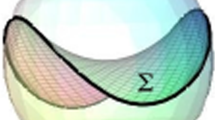Abstract.
The effect of conductor boundaries on the deformation and stability of a charged drop is presented. The motivation for such a study is the occurrence of a charged conductor drop near a conductor wall in experiments (Millikan-like set-up in studies on Rayleigh break-up) and applications (such as electrospraying, ink-jet printing and ion mass spectroscopy). In the present work, analytical (linear stability analysis (LSA)) and numerical methods (boundary element method (BEM)) are used to understand the instability. Two kinds of boundaries are studied: a spherical, conducting, grounded enclosure (similar to a spherical capacitor) and a planar conducting wall. The LSA of a charged drop placed at the center of a spherical cavity shows that the Rayleigh critical charge (corresponding to the most unstable l = 2 Legendre mode) is reduced as the non-dimensional distance \( \hat{d}\) = \( {\frac{{b-a}}{{a}}}\) decreases, where a and b are the radii of the drop and spherical cavity, respectively. The critical charge is independent of the assumptions of constant charge or constant potential conditions. The trans-critical bifurcation diagram, constructed using BEM, shows that the prolate shapes are subcritically unstable over a much wider range of charge as \( \hat{d}\) decreases. The study is then extended to the stability of a charged conductor drop near a flat conductor wall. Analytical theory for this case is difficult and the stability as well as the bifurcation diagram are constructed using BEM. Moreover, the induced charges in the conductor wall lead to attraction of the drop to the wall, thereby making it difficult to conduct a systematic analysis. The drop is therefore assumed to be held at its position by an external force such as the electric field. The case when the applied field is much smaller than the field due to inherent charge on the drop ( \( {\frac{{a^3\rho g}}{{3\epsilon_0\psi^2}}}\) ≪ 1 is considered. The wall breaks the fore-aft symmetry in the problem, and equilibrium, predominantly prolate shapes corresponding to the legendre mode, l = 2 , are observed. The deformation increases with increasing charge on the drop. The breakup of the prolate equilibrium shapes is independent of the legendre modes of the initial perturbations. The prolate perturbations are subcritically unstable. Since the equilibrium prolate shapes cannot continuously exchange instability with equilibrium oblate shapes, an imperfect transcritical bifurcation is observed. A variety of highly deformed equilibrium oblate shapes are predicted by the BEM calculations.
Similar content being viewed by others
References
N. Ashgriz, Handbook of Atomization and Sprays (Springer, New York, 2011)
A. Kazutoshi, J. Electrost. 18, 63 (1986)
J.W.S. Rayleigh, Philos. Mag. 14, 184 (1882)
D. Duft, T. Achtzehn, R. Muller, B.A. Huber, T. Leisner, Nature 421, 128 (2003)
E. Giglio, B. Gervais, J. Rangama, B. Manil, B.A. Huber, D. Duft, R. Muller, T. Leisner, C. Guet, Phys. Rev. E. 77, 036319 (2008)
A. Doyle, D.R. Moffett, B. Vonnegut, J. Colloid Sci. 19, 136 (1964)
C.B. Richardson, H. Pigg, R.L. Hightower, Proc. R. Soc. London, Ser. A 422, 319 (1988)
J.A. Tsamopoulos, T.R. Akylas, R.A. Brown, Proc. R. Soc. London, Ser. A 401, 67 (1985)
A. Gomez, K. Tang, Phys. Fluids 6, 404 (1994)
K. Tang, A. Gomez, Phys. Fluids 6, 2317 (1994)
W. Deng, A. Gomez, Int. J. Heat Mass Transfer 54, 2270 (2011)
S. Chandra, C. Avedisian, Proc. R. Soc. London, Ser. A 432, 13 (1991)
M. Pasandideh-Fard, Y.M. Qiao, S. Chandra, J. Mostaghimi, Phys. Fluids 8, 650 (1996)
C. Tropea, I.V. Roisman, Atomiz. Sprays 10, 387 (2000)
J. Fukai, Y. Shiba, T. Yamamoto, O. Miyatake, D. Poulikakos, M. Megaridis, Z. Zhao, Phys. Fluids 7, 236 (1995)
M.R. Davidson, Chem. Eng. Sci. 55, 1159 (2000)
C. Pozrikidis, J. Fluid Mech. 215, 331 (1990)
S.I. Betelu, M.A. Fontelos, Physica D 209, 28 (2005)
S.U. Ryu, S.Y. Lee, Int. J. Multiphase Flow 35, 1 (2009)
T. Erneux, P. Mandel, SIAM J. Appl. Math. 46, 1 (1986)
O.A. Basaran, L.E. Scriven, Phys. Fluids A 1, 799 (1989)
T. Achtzehn, R. Muller, D. Duft, T. Leisner, Eur. Phys. J. D 34, 311 (2005)
R.B. Bird, W.E. Stewart, E.N. Lightfoot, Transport Phenomena (John Wiley and Sons, New York, 2002)
H.A. Stone, L.G. Leal, J. Fluid Mech. 220, 161 (1990)
C. Pozrikidis, Boundary Integral and Singularity Methods for Linearized Viscous Flow (Cambridge University Press, Cambridge, 1992)
W.J. Cody, Math. Comput. 19, 105 (1965)
C. Hastings, Approximations for Digital Computers (Princeton University Press, New Jersey, 1965)
R.M. Thaokar, S.D. Deshmukh, Phys. Fluids 22, 034107 (2010)
J. Blake, Proc. Cambridge Philos. Soc. 70, 303 (1971)
Author information
Authors and Affiliations
Corresponding author
Rights and permissions
About this article
Cite this article
Mhatre, S.E., Deshmukh, S.D. & Thaokar, R.M. Stability of a charged drop near a conductor wall. Eur. Phys. J. E 35, 39 (2012). https://doi.org/10.1140/epje/i2012-12039-4
Received:
Revised:
Accepted:
Published:
DOI: https://doi.org/10.1140/epje/i2012-12039-4



